

- #Microsoft word document recovery slow how to#
- #Microsoft word document recovery slow install#
- #Microsoft word document recovery slow update#
- #Microsoft word document recovery slow full#
- #Microsoft word document recovery slow windows 10#

So, to find all documents with “project” anywhere in their name, you’d run: winfr C: D: /n *project* To find all files with a word in their name, use wildcards. To search for all DOCX files on drive C: and copy them to drive D:, you’d run the following command: winfr C: D: /n *.docxĪs we mentioned above, you’ll find the recovered files in a directory named “Recovery_” on the destination drive you specified in the command line. For example /n UsersBobDocuments*.docx will find all DOCX files there were in the Documents folder.
#Microsoft word document recovery slow full#
You can also specify a full path to the file, such as /n UsersBobDocumentsdocument.docx

#Microsoft word document recovery slow windows 10#
Are you trying to find a file you recently deleted on a drive formatted with NTFS, which is the default Windows 10 and 11 file system? Use Default mode.Here’s when you should use the different modes: To find this, open File Explorer, right-click the drive under This PC, and select “Properties.” You’ll see the file system displayed on the “General” tab. You’ll need to know what file system the drive you’ll be scanning is formatted with. (Searching for “ZIP” files will also find Office documents stored in formats like DOCX, XLSX, and PPTX.) Signature mode can search for files by type-it supports ASF, JPEG, MP3, MPEG, PDF, PNG, and ZIP files. Default is the fastest mode, while Segment is similar but slower and more thorough. There are three modes, Default, Segment, and Signature. Which Mode Should You Use?īefore you continue, you should determine the “mode” you want to scan for the deleted file. Here’s the basic format: winfr source-drive: destination-drive: /switchesĪfter running the command, the tool will automatically create a directory named “Recovery_” on the destination drive you specify. You must save the deleted file to a different drive. To use this tool, you will run the winfr command, specifying the drive you want to search for the deleted file, the destination you want to save it to, and the various switches that control what the tool searches for and how it searches.
#Microsoft word document recovery slow how to#
How to Recover Deleted Files on Windows 10 and Windows 11 (In the Start menu, right-click the one you want to use and select “Run as Administrator.”) You can use other command-line environments like the Windows Terminal and PowerShell, but be sure to launch them with Administrator access. This is where you’ll run the File Recovery commands. You’ll see a Command Prompt window with Administrator access. Once it’s installed, open your Start menu and search for “File Recovery.” Launch the “Windows File Recovery” shortcut once and click “Yes” to the UAC prompt. You can open the Store and search for “Windows File Recovery” or just click that link to open the Store.
#Microsoft word document recovery slow install#
To get started, install the Windows File Recovery tool from the Microsoft Store to get started. We’ll explain which you should use and how to use them. The utility also has multiple modes intended for different situations and file systems. There are no guarantees here, and that’s why backups are so important. You can only get whatever data is still on the drive. If you’ve written a lot of data to a device like an SD card since you’ve deleted the file, it’s likely that the file’s data may have been overwritten.Įven if you manage to recover a file, you may only get some of the file’s data-the file may be corrupted. Deleted files aren’t removed from hard drives immediately, but they often are removed from solid-state drives immediately. Whether Microsoft’s tool can actually find and recover a file you’ve deleted depends on the drive. It doesn’t run on older versions of Windows.
#Microsoft word document recovery slow update#
This tool requires you’ve installed Windows 10’s May 2020 Update or newer, or any version of Windows 11. We’ll show you how to use it, but it’s a more hands-on process than you might expect from an official Microsoft utility available in the Microsoft Store. Microsoft’s Windows File Recovery tool doesn’t have a graphical interface-it’s only a command-line utility.


 0 kommentar(er)
0 kommentar(er)
